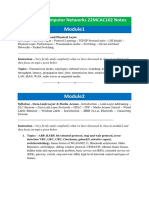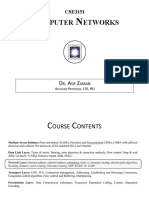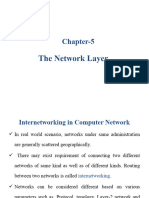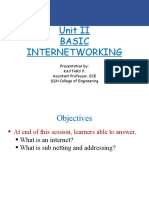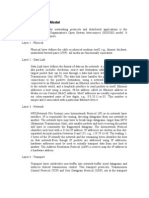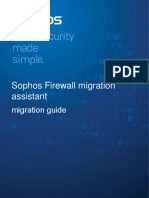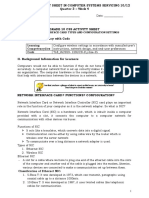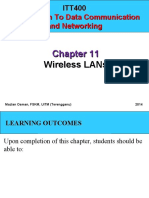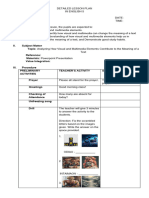Lec# 10 TCP/IP Reference Model Computer Science Dept.
, Diyala University
EX: What is the subnetwork address if the destination address is 200.45.34.56 and the
subnet mask is 255.255.240.0?
11001000 00101101 00100010 00111000
11111111 11111111 11110000 00000000
11001000 00101101 00100000 00000000
The subnetwork address is 200.45.32.0.
Short-Cut Method
** If the byte in the mask is 255, copy the byte in the address.
** If the byte in the mask is 0, replace the byte in the address with 0.
** If the byte in the mask is neither 255 nor 0, we write the mask and the address in binary
and apply the AND operation.
EX: What is the subnetwork address if the destination address is 19.30.80.5 and the mask is
255.255.192.0?
Data Communication and Computer Networks, 4th Stage ( 901) Yahiea Al-Naiemy
�Lec# 10 TCP/IP Reference Model Computer Science Dept., Diyala University
Comparison of a default mask and a subnet mask:
The number of subnets must be a power of 2.
Variable-length subnetting:
Data Communication and Computer Networks, 4th Stage ( 990) Yahiea Al-Naiemy
�Lec# 10 TCP/IP Reference Model Computer Science Dept., Diyala University
SUPERNETTING:
A supernetwork:
Rules:
** The number of blocks must be a power of 2 (1, 2, 4, 8, 16, . . .).
** The blocks must be contiguous in the address space (no gaps between the blocks).
** The third byte of the first address in the superblock must be evenly divisible by the
number of blocks. In other words, if the number of blocks is N, the third byte must be
divisible by N.
EX: A company needs 600 addresses. Which of the following set of class C blocks can be
used to form a supernet for this company?
198.47.32.0 198.47.33.0 198.47.34.0
198.47.32.0 198.47.42.0 198.47.52.0 198.47.62.0
198.47.31.0 198.47.32.0 198.47.33.0 198.47.52.0
198.47.32.0 198.47.33.0 198.47.34.0 198.47.35.0
1: No, there are only three blocks.
2: No, the blocks are not contiguous.
Data Communication and Computer Networks, 4th Stage ( 999) Yahiea Al-Naiemy
�Lec# 10 TCP/IP Reference Model Computer Science Dept., Diyala University
3: No, 31 in the first block is not divisible by 4.
4: Yes, all three requirements are fulfilled.
In subnetting, we need the first address of the subnet and the subnet mask to define the
range of addresses. In supernetting, we need the first address of the supernet and the
supernet mask to define the range of addresses.
Comparison of subnet, default, and supernet masks:
CLASSLESS ADDRESSING:
Variable-length blocks
Number of Addresses in a Block:
There is only one condition on the number of addresses in a block; it must be a power of 2
(2, 4, 8, . . .). A household may be given a block of 2 addresses. A small business may be
given 16 addresses. A large organization may be given 1024 addresses.
Beginning Address:
Data Communication and Computer Networks, 4th Stage ( 991) Yahiea Al-Naiemy
�Lec# 10 TCP/IP Reference Model Computer Science Dept., Diyala University
The beginning address must be evenly divisible by the number of addresses. For example, if
a block contains 4 addresses, the beginning address must be divisible by 4. If the block has
less than 256 addresses, we need to check only the rightmost byte. If it has less than 65,536
addresses, we need to check only the two rightmost bytes, and so on.
EX: Which of the following can be the beginning address of a block that contains 16
addresses?
205.16.37.32
190.16.42.44
17.17.33.80
123.45.24.52
The address 205.16.37.32 is eligible because 32 is divisible by 16. The address 17.17.33.80
is eligible because 80 is divisible by 16.
Slash notation:
EX: A small organization is given a block with the beginning address and the prefix length
205.16.37.24/29 (in slash notation). What is the range of the block?
The beginning address is 205.16.37.24. To find the last address we keep the first 29 bits and
change the last 3 bits to 1s.
Beginning:11001111 00010000 00100101 00011000
Ending : 11001111 00010000 00100101 00011111
There are only 8 addresses in this block.
We can find the range of addresses previous Example by another method. We can argue
that the length of the suffix is 32 - 29 or 3. So there are 23 = 8 addresses in this block. If the
Data Communication and Computer Networks, 4th Stage ( 991) Yahiea Al-Naiemy
�Lec# 10 TCP/IP Reference Model Computer Science Dept., Diyala University
first address is 205.16.37.24, the last address is 205.16.37.31 (24 + 7 = 31).
A block in classes A, B, and C can easily be represented in slash notation as A.B.C.D/ n
where n is either 8 (class A), 16 (class B), or 24 (class C).
Layer 4: Transport layer:
The TCP/IP model has two main protocols in transport layer:
a) TCP (Transmission Control Protocol):
1- TCP is connection oriented protocol.
2- TCP was designed to provide a reliable end to end byte stream over unreliable
internetwork.
3- TCP was designed to be robust in the face of many kinds of failures.
1- TCP entity accepts user data streams (messages) from local process, breaks them
into pieces not exceeding 64k bytes (usually about 1500 bytes) and sends each
piece as a separate IP datagram. When IP datagrams that containing TCP data
arrive the destination machine, they are given to the TCP entity, which reconstruct
the original byte streams. The IP layer gives no guarantee that datagrams will be
delivered properly, so it is up to TCP to time out and retransmit them as need be.
2- Datagrams that arrive may well do so in the wrong order; it is also up to TCP to
reassemble them into messages in the proper sequence.
3- The sending and receiving entities exchange data in the form of segments. A
segment consists of a fixed 20 byte header (plus an optional part) followed by zero
or more data bytes. The TCP decides how big segments should be. Segments
without any data are legal and are commonly used for acknowledgments and
control messages.
b) UDP (User Data Protocol):
UDP is connectionless transport protocol that provides a way for sending a raw IP
datagrams without establish a connection. Many client server applications have one request
Data Communication and Computer Networks, 4th Stage ( 991) Yahiea Al-Naiemy
�Lec# 10 TCP/IP Reference Model Computer Science Dept., Diyala University
and one response use UDP rather than go to trouble of establishing and releasing a
connection.
Layer 5: Application layer:
This layer contains all the higher level protocols, such as: TELNET (Terminal
Network: enables the establishment of a connection to a remote system in such way that the
local terminal appears to be a terminal at the remote system), FTP (File Transfer), SMTP
(Electronic Mail), and DNS (Domain Name System).
Data Communication and Computer Networks, 4th Stage ( 991) Yahiea Al-Naiemy












